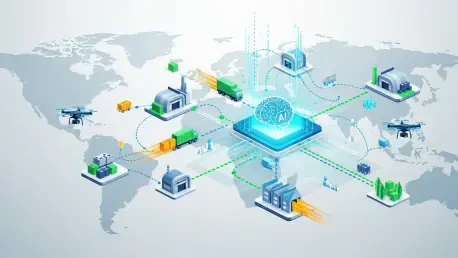The logistics industry stands at a critical juncture, grappling with unprecedented complexities in global supply chains while facing mounting pressure to deliver faster, cheaper, and more reliable services. As disruptions like geopolitical tensions and fluctuating demand continue to challenge shippers and carriers, a powerful ally has emerged in the form of generative artificial intelligence (AI). This cutting-edge technology, capable of analyzing vast datasets to produce actionable insights and responses, is rapidly integrating into transportation management systems (TMS) to revolutionize operations. By automating tedious tasks, enhancing visibility, and predicting potential hurdles, generative AI is not just a tool but a transformative force reshaping how logistics professionals manage their networks. This article explores the multifaceted impact of this technology, delving into its practical applications, adoption challenges, and the broader trends signaling a fundamental shift in the industry’s approach to efficiency and innovation.
The Push for Accessibility and Efficiency
Revolutionizing User Interaction
Generative AI is breaking down long-standing barriers in logistics technology by making systems far more intuitive and user-friendly for a diverse range of professionals. Traditional TMS platforms often require specialized training, creating a steep learning curve for non-technical staff. In contrast, generative AI leverages natural language processing to enable conversational interactions, allowing users to engage with complex systems as easily as they would with a coworker. A prime example is Uber Freight’s innovative “logistics copilot,” which empowers users to pose intricate questions about market dynamics or operational metrics and receive clear, actionable feedback in real time. This democratization of technology ensures that even those without deep expertise can harness powerful tools, streamlining workflows and fostering broader adoption across teams. The result is a significant reduction in time spent on manual queries, freeing up personnel to focus on strategic priorities rather than navigating cumbersome interfaces.
Beyond simplifying interactions, generative AI enhances the explainability of data, a crucial factor in building trust and usability within logistics operations, and it does so by transforming complex information into accessible insights for users. Instead of presenting raw numbers or opaque outputs, AI-driven tools provide detailed reasoning behind their insights, making decision-making more transparent. Amazon’s implementation of chatbots in shipper-facing portals exemplifies this trend, offering real-time updates on shipments while articulating the logic behind delays or rerouting decisions. This clarity not only saves time by eliminating the need for follow-up calls or emails but also empowers users to make informed choices swiftly. Hardik Chawla from Amazon has emphasized how such transparency transforms user experience, turning data into a narrative that stakeholders can easily grasp. As a result, generative AI is fostering a more collaborative environment where technology serves as a bridge between complex systems and human operators, ultimately driving efficiency in day-to-day logistics management.
Enhancing Operational Visibility
Another profound impact of generative AI lies in its ability to provide unparalleled visibility across supply chain networks, a critical need in an era of constant disruption. By processing and synthesizing data from disparate sources, AI tools offer a holistic view of operations, enabling stakeholders to track shipments, monitor performance, and identify bottlenecks in real time. For instance, platforms integrating generative AI can generate dynamic reports that highlight inefficiencies or predict potential delays based on current trends. This level of insight allows logistics managers to shift from reactive problem-solving to proactive planning, addressing issues before they escalate. The accessibility of such detailed visibility through user-friendly interfaces means that even smaller players in the logistics space can compete with larger entities, leveling the playing field and fostering innovation across the board.
Moreover, generative AI’s role in enhancing visibility extends to improving communication between various supply chain partners, ensuring alignment and reducing friction. Conversational AI tools can automatically update all relevant parties on shipment statuses, customs clearances, or unexpected changes, minimizing misunderstandings that often lead to costly delays. This seamless flow of information builds stronger partnerships between shippers, carriers, and third-party providers, as everyone operates with the same up-to-date data. The technology’s capacity to distill complex datasets into digestible summaries or alerts further amplifies its value, allowing teams to focus on critical decision points rather than sifting through endless reports. As supply chains grow more interconnected, the clarity and immediacy provided by generative AI are becoming indispensable for maintaining smooth, efficient operations in a highly competitive landscape.
Practical Applications and Benefits
Optimizing Operations and Cutting Costs
Generative AI is proving to be a versatile asset in logistics, tackling a spectrum of operational challenges with precision and foresight, making it an invaluable tool for modern supply chain management. One of its most impactful applications is in cost reduction, where AI analyzes extensive datasets to uncover hidden savings opportunities that might escape human scrutiny. For example, by evaluating historical shipping data, generative AI can recommend more cost-effective routes or suggest optimal load consolidations, directly impacting bottom lines. Companies leveraging this technology report significant reductions in transportation expenses, as the system identifies inefficiencies in real time and proposes actionable fixes. This ability to transform raw information into strategic insights positions generative AI as a cornerstone for financial efficiency, enabling firms to allocate resources more effectively in an industry where margins are often razor-thin.
In addition to cost savings, generative AI excels at optimizing delivery schedules, a critical component of customer satisfaction and operational success. By processing variables such as traffic patterns, weather conditions, and delivery windows, AI systems can dynamically adjust schedules to ensure timely arrivals while minimizing fuel consumption. JourneyTMS, for instance, harnesses historical data to predict shipping rates for uncharted lanes, helping planners make informed decisions even in unfamiliar territories. This predictive capability not only streamlines operations but also enhances reliability, as shippers can anticipate and mitigate potential disruptions before they impact service levels. The ripple effect of such optimization is felt across the supply chain, as improved scheduling reduces idle times for carriers and ensures products reach consumers without unnecessary delays, bolstering trust and loyalty in a competitive market.
Proactive Problem-Solving and Innovation
Generative AI’s capacity for proactive problem-solving marks a significant departure from traditional reactive approaches in logistics management, revolutionizing how challenges are addressed. By anticipating shippers’ needs and identifying potential issues before they manifest, AI tools help prevent disruptions that could derail operations. For instance, systems can flag shipments at risk of delay due to port congestion or regulatory hurdles, allowing managers to reroute or expedite processes preemptively. This forward-thinking approach minimizes downtime and associated costs, ensuring smoother workflows even in volatile conditions. The technology’s ability to learn from past incidents and adapt to evolving patterns further strengthens its role as a safeguard against the unpredictable nature of global supply chains, offering a level of preparedness that manual systems struggle to match.
Furthermore, generative AI is driving innovation by enabling personalized solutions tailored to specific logistics challenges, enhancing both efficiency and user engagement. Tools like Dynasty Pro TMS’s “Trucker Buddy” provide drivers with real-time recommendations for parking or rest stops based on load data and hours-of-service regulations, improving safety and compliance. Such customized applications demonstrate how AI can address niche pain points while scaling across broader operations. By automating routine tasks and offering context-specific insights, the technology frees up human resources for higher-value activities like strategy and relationship-building. As logistics firms continue to explore these innovative use cases, generative AI is paving the way for a more agile and responsive industry, capable of adapting to unique demands with unprecedented speed and accuracy.
Challenges and Strategies for Adoption
Embracing Experimentation
The journey to integrate generative AI into logistics management is still in its formative stages, characterized by a culture of trial and error that reflects the technology’s nascent status. Industry leaders acknowledge that there is no universal roadmap for successful implementation, as each company grapples with unique operational needs and technological readiness. Brad Little from Dynasty Pro TMS describes this process as an ongoing cycle of building, testing, and refining, where lessons learned from initial deployments shape future strategies. This experimental mindset is evident in initiatives like Oracle’s recent AI enhancements, which evolve through iterative feedback loops to better align with user expectations. Embracing such adaptability is essential, as it allows firms to navigate the uncertainties of integrating cutting-edge tools while steadily improving performance and reliability in their TMS platforms.
Navigating the challenges of adoption also requires a willingness to invest in continuous learning and cross-functional collaboration to maximize generative AI’s potential. Many organizations face hurdles such as data quality issues or resistance to change among staff accustomed to legacy systems. Addressing these barriers involves not only technical upgrades but also cultural shifts, where training programs and change management play pivotal roles. Pilot projects, such as those rolling out conversational AI for specific logistics functions, provide valuable insights into scalability and user acceptance. By starting small and iterating based on real-world outcomes, companies can mitigate risks while building confidence in the technology’s capabilities. This cautious yet progressive approach underscores the industry’s commitment to harnessing generative AI as a long-term solution, even as short-term obstacles demand patience and persistence.
Building Trust and Infrastructure
A significant challenge in adopting generative AI lies in establishing trust in its outputs, particularly when decisions impact high-stakes logistics operations, where stakeholders often hesitate to rely on AI recommendations without understanding the underlying logic. This hesitation is especially pronounced in scenarios involving financial or safety implications. To counter this, technology providers are prioritizing transparency, ensuring that systems articulate the reasoning behind suggestions or predictions. For example, platforms that explain why a particular route was chosen over another help users feel more confident in AI-driven decisions. Building this trust is a gradual process, requiring consistent performance and clear communication to demonstrate that generative AI can be a reliable partner rather than an opaque black box in critical supply chain functions.
Equally important is the need to develop robust infrastructure to support the seamless integration of generative AI into existing logistics frameworks. Many companies struggle with fragmented data systems or outdated software that hinder AI’s effectiveness, necessitating significant investments in modernization. Upgrading to cloud-based platforms or unifying data sources can enhance AI’s ability to deliver accurate insights, but such transitions often come with high costs and logistical challenges. Collaboration between tech providers and logistics firms is key to tailoring solutions that align with specific operational needs while ensuring scalability. As infrastructure evolves to accommodate generative AI, the industry moves closer to realizing the full spectrum of benefits, from streamlined processes to data-driven decision-making, setting the stage for widespread transformation.
Balancing Technology and Human Insight
The Hybrid Approach
As generative AI reshapes logistics management, a critical theme emerging is the need to balance automation with human oversight to ensure optimal outcomes. While AI excels at processing vast datasets and generating recommendations at lightning speed, it lacks the nuanced understanding of context that human decision-makers bring to the table. Industry experts like Chris Orban from JourneyTMS advocate for a hybrid model where AI handles the grunt work of data analysis and pattern recognition, while humans retain authority over final decisions. This synergy ensures that technology acts as an enabler, providing actionable insights without overstepping into areas where emotional intelligence or strategic judgment is paramount. Such a balance prevents potential missteps in scenarios where data alone cannot capture the full scope of business priorities or customer expectations.
This hybrid approach also fosters accountability, a cornerstone of effective logistics management in an AI-driven era. By positioning humans as the ultimate arbiters, companies can safeguard against the risks of over-reliance on algorithms, such as biases in data or unforeseen errors in automated processes. For instance, while AI might suggest a cost-effective shipping route, a manager can assess whether it aligns with customer commitments or long-term partnerships that data might overlook. This collaborative dynamic not only mitigates risks but also enhances trust in technology, as stakeholders see AI as a supportive tool rather than a replacement for human expertise. As logistics operations grow increasingly complex, maintaining this equilibrium between machine efficiency and human insight will be essential to navigating challenges with both precision and perspective.
Preserving Strategic Decision-Making
Generative AI’s role in logistics must complement rather than overshadow the strategic decision-making that drives long-term success in the industry, ensuring that technology supports rather than supplants human expertise. Automation can streamline routine tasks like scheduling or tracking, but high-level choices—such as entering new markets or negotiating carrier contracts—require a depth of experience and foresight that technology cannot replicate. Human leaders bring an understanding of industry trends, regulatory landscapes, and stakeholder relationships, ensuring that AI outputs are contextualized within broader business goals. This preservation of strategic oversight allows firms to leverage generative AI for tactical efficiency while reserving critical thinking for areas where intuition and vision shape competitive advantage, maintaining a clear delineation of roles in an increasingly automated landscape.
Moreover, emphasizing human involvement in strategic areas reinforces the adaptability of logistics operations to dynamic market conditions that AI might not fully predict. While generative AI can model scenarios based on historical data, unexpected shifts—such as sudden policy changes or geopolitical events—often demand rapid, creative responses grounded in human judgment. By integrating AI as a decision-support tool rather than a decision-maker, companies ensure flexibility in their strategies, allowing them to pivot swiftly when circumstances evolve beyond algorithmic forecasts. This balanced framework not only maximizes the benefits of generative AI but also upholds the irreplaceable value of human leadership, ensuring that logistics management remains both innovative and resilient in the face of uncertainty.
Industry Trends and Future Outlook
A Growing Movement
The adoption of generative AI within logistics management reflects a broader industry trend toward modernization and data-driven transformation, signaling a shift that is both widespread and accelerating. A Deloitte study indicates that 75% of surveyed executives have already incorporated generative AI into their supply chain operations, with an additional 16% actively piloting applications. This significant uptake underscores a growing recognition of AI’s potential to enhance responsiveness and efficiency in transportation management systems. From optimizing routes to automating customer communications, the technology is becoming a linchpin for firms aiming to stay competitive in a fast-paced market. As more organizations witness tangible benefits, the momentum behind generative AI adoption continues to build, positioning it as a cornerstone of future logistics strategies.
This growing movement is further fueled by the push to democratize technology, ensuring that tools powered by generative AI are accessible to companies of all sizes, not just industry giants. User-friendly interfaces and conversational AI systems lower the entry barrier, enabling smaller logistics providers to harness sophisticated capabilities without requiring extensive resources or expertise. This trend aligns with a broader industry shift toward inclusivity, where technology empowers a wider range of stakeholders to improve their operations. Over the coming years, as generative AI solutions become more refined and cost-effective, their integration is expected to deepen, driving a wave of innovation that reshapes how supply chains are managed. The trajectory points to an era where agility and insight, powered by AI, become standard expectations rather than exceptional advantages.
Shaping the Future of Supply Chains
Looking ahead, generative AI stands poised to redefine the very structure of supply chains by embedding intelligence into every layer of logistics management. Its ability to anticipate disruptions, personalize solutions, and optimize resources in real time suggests a future where supply chains are not just reactive but predictive and adaptive. Industry leaders envision scenarios where AI systems seamlessly coordinate between shippers, carriers, and end customers, creating ecosystems that operate with minimal friction. This vision extends beyond operational efficiency to sustainability, as AI-driven insights could minimize waste and energy use through smarter routing and load planning. As experimentation with generative AI matures, its role in crafting resilient, forward-thinking supply chains will likely become a defining feature of the industry’s evolution.
The path forward also hinges on collaboration between technology providers and logistics firms to address emerging needs and refine AI applications over time, ensuring that the industry keeps pace with rapid advancements. Joint efforts to enhance data interoperability and develop industry-specific solutions will be crucial for scaling generative AI’s impact. Additionally, regulatory frameworks and ethical considerations surrounding data privacy and AI accountability will shape how swiftly and responsibly this technology is deployed. By fostering dialogue and innovation, stakeholders can ensure that generative AI evolves in ways that benefit the entire logistics ecosystem. Reflecting on the strides made in recent years, it’s evident that the groundwork laid through early adoption and iterative learning has set the stage for transformative progress, promising a future where supply chains are smarter, more connected, and better equipped to handle global demands.









